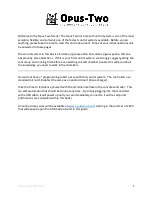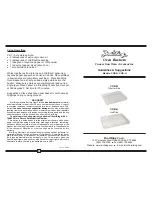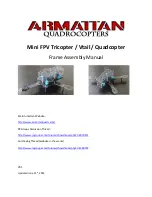
TLS Magnetostrictive Probes International Installation Guide
Before You Begin
4
Except for the cables used to connect intrinsically safe apparatus, information contained on the system certificate
and each of the device certificates, provide the safety related information (Ex ia) required to install a TLS
Monitoring System. Cables used to connect intrinsically safe apparatus must be considered in determining
compliance and are limited to the maximum allowable cable parameters listed in this manual. For assistance in
calculating the required (Ex ia) safety parameters, contact GVR as described on the inside cover of this manual.
For European Community (EC) installations, additional equipment compliance information is available on the EC
Declaration of Conformity including reference to the technical standards applied by the Notified Body in creating
the respective ATEX Certificates.
THESE ARE THE CONDITIONS FOR SAFE USE WHEN INSTALLING A MAG PROBE
1.
The devices have been evaluated in conjunction with the intrinsic safety system defined in DEMKO 06 ATEX
137480X. The descriptive system documents and manuals included with the aforementioned certificate must
be followed during installation and the appropriate Veeder Root accessories must be used. Manual 577014-
031 details applicable process connections in accordance with EN 60079-26.
2.
The following condition of safe use applies to the Mag Sump Sensor: Before installing or taking into a
hazardous area, earth the unit in a Safe Area to remove any static charge. Then immediately transport the unit
to the installation site; do not rub or clean the unit prior to installation. Cleaning is not required under normal
service conditions; do not rub or clean the device after installation. If the unit is not fixed to a known earth
point when installed, ensure that a separate earth connection is made to prevent the potential of static
discharge. When fitting or removing the unit, use of anti-static footwear & clothing is required.
3.
The enclosure contains aluminum. Care must be taken to avoid ignition hazards due to impact of friction.
ATTENTION!
Important Considerations - Read Prior to Installation - Metallic/Steel Tanks
Process Connection (gland):
Must be used in locations where it is mandatory that the Mag Probe be
equipotentially bonded to the tank structure.
Riser Pipe:
May be used in locations that do not require bonding between the Mag Probe and the tank structure.
Reference European Norm IEC/EN 60079-14: Explosive atmospheres - Part 14: Electrical installations design,
selection and erection.
Cathodically Protected Tanks:
Installation selection is dependent on the considerations listed above for the
Process Connection and the Riser Pipe.
Only install TLS Magnetostrictive Probes according to one of the four procedures listed below:
Wired Connections
– Mag Probe to ATG Console wiring - see Figures 1 and 18.
1.
Process Connection (gland) – Zone 1 installation, Surge Protector not required
2.
Riser Pipe – Zone 0 installation, Surge Risk Protection Assessment (SRPA) required
Wireless Communication
– Mag Probe with RF hardware - see Figures 2, 24 and 25
3.
Process Connection (gland) – Zone 1 installation, surge protector not required
4.
Riser Pipe – Zone 0 installation, Surge Protector required
Before You Begin
1.
Consult any local regulations prior to proceeding to determine the best installation method. The instructions
below detail how to safely install probes with process connections or in a riser pipe and will also help in
determining when surge protection is required or may be necessary.
2.
Depending on the considerations above, perform a Surge Risk Protection Assessment (SRPA) of equipment
in the site. A (SRPA) checklist is available on our website at
http://www.veeder.com/page/Probe_Manuals
.
3.
Verify the equipment needed to complete the installation as described in this manual, and, if necessary, any
equipment required following completion of the site Surge Risk Protection Assessment (SRPA).









































